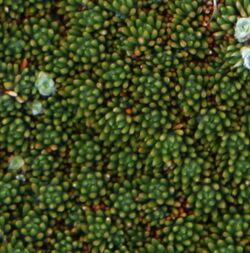Biology:Abrotanella forsteroides
| Abrotanella forsteroides | |
|---|---|

| |
| Scientific classification | |
| Kingdom: | Plantae |
| Clade: | Tracheophytes |
| Clade: | Angiosperms |
| Clade: | Eudicots |
| Clade: | Asterids |
| Order: | Asterales |
| Family: | Asteraceae |
| Genus: | Abrotanella |
| Species: | A. forsteroides
|
| Binomial name | |
| Abrotanella forsteroides (Hook.f.) Benth.
| |
| Synonyms | |
| |
Abrotanella forsteroides, commonly known as the Tasmanian cushion plant, is an endemic angiosperm of Tasmania, Australia. The plant is a dicot species of the daisy family Asteraceae and can be identified by its bright green and compact cushion like appearance.
The term cushion plant refers to a characteristic growth habit adopted by a variety of species and families growing in alpine and subalpine environments. The growth habit is an adaptation to low nutrient areas and typically involves deep tap roots and densely-packed stems, which decay to form a layer of peat under the plants. This dense growth pattern provides insulating properties to the plant, preventing root exposure to sub-zero temperatures, and forms a mat- or cushion-like structure.[1]
Description
A herbaceous perennial, the plant is low growing, woody, compact and spreads in mat-like manner to 3m in diameter.[1] The large mat is commonly interspersed with other cushion plant species such as Dracophyllum minimum and Donatia novae-zelandiae[2]. Leaves bright green, thick, crowded and sheathing from the base to a pointed tip with a single fine hair, the blades 2mm long.[3] Flowering occurs from December–February. The flowers are small, solitary, tubular and white, positioned above the foliage.[3]
Abrotanella forsteroides is commonly mistaken for Dracophyllum minimum and Donatia novae-zelandieae due to their vegetatively similar appearances. However, D. minimum is distinguished by its reddish leaf tips and lack of hair and D. novae-zelandiae is distinguished by the presence of hairy leaf axils.[4]
Habitat and conservation issues
Abrotanella forsteroides is commonly found in alpine and sub-alpine regions of Tasmania above 1,200m.[5] The plant is widespread in screes and alpine moors, and forms mosaics with other cushion plants. Typically occupying areas with high rainfall and poorly drained, shallow fibrous peaty soils.[6]
Cushion plants are extremely sensitive to being trampled on by bushwalkers due to their slow growing nature.[7]
References
- ↑ 1.0 1.1 Gibson, Neil. Ph.D. Thesis - 'A study on the biology of four Tasmanian cushion species. https://core.ac.uk/download/pdf/33330242.pdf.
- ↑ "Key to Tasmanian Dicots". https://www.utas.edu.au/dicotkey/dicotkey/AST/fAsteraceaeC_1.htm.
- ↑ 3.0 3.1 Howells, Christine (2021). Tasmania’s Natural Flora (3rd ed.).
- ↑ "Key to Tasmanian Dicots". https://www.utas.edu.au/dicotkey/dicotkey/AST/ast/sAbrotanella_forst.htm.
- ↑ Wagstaff, Steven J.; Breitwieser, Ilse; Swenson, Ulf (2006). "Origin and Relationships of the Austral Genus Abrotanella (Asteraceae) Inferred from DNA Sequences". Taxon 55 (1): 95–106. doi:10.2307/25065531. ISSN 0040-0262. https://www.jstor.org/stable/25065531.
- ↑ "From Forest to Fjaeldmark: Descriptions of Tasmania's Vegetation (Edition 2) | Department of Natural Resources and Environment Tasmania". https://nre.tas.gov.au/conservation/flora-of-tasmania/from-forest-to-fjaeldmark-descriptions-of-tasmanias-vegetation.
- ↑ "Cushion plants | Parks & Wildlife Service Tasmania". https://parks.tas.gov.au/discovery-and-learning/plants/cushion-plants.
Wikidata ☰ Q2821973 entry
 |


